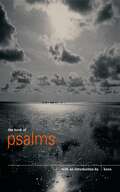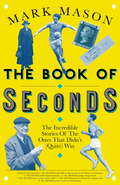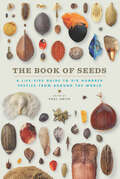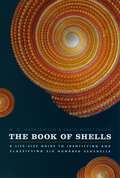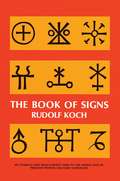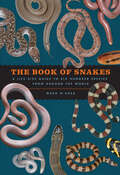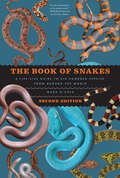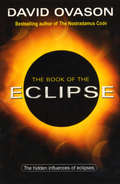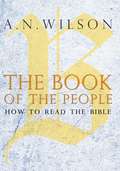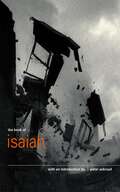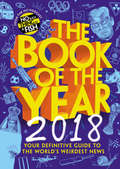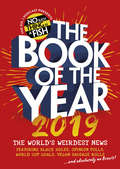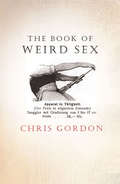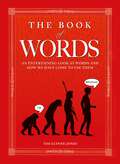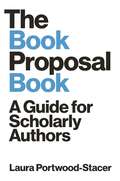- Table View
- List View
The Book of Psalms (The Pocket Canons #15)
by BonoThrough the ages, the book of Psalms has been regarded as the most inspirational of all the Bible's books. It is not known how or when the collection of 150 lyrical poems came into existence, though many are ascribed to King David. The text is introduced by U2 singer Bono.
The Book of Seconds: The Incredible Stories of the Ones that Didn’t (Quite) Win
by Mark MasonDID YOU KNOW that the second man to swim the Channel drank 20 drops of champagne every hour? Or that the second crew to land on the Moon danced to a pop song in zero gravity? Or that the second man to run a sub-4-minute mile once stopped to check on a fallen rival - but still managed to win the race?You probably didn't - because seconds never get the attention they deserve. This book reveals the people and things who until now have been kept in the shadow of the firsts. We'll glory in the achievements of the nearly-men and nearly-women, not to mention nearly-skyscrapers, nearly-LPs and nearly-deserts.Above all we'll see how so-called 'runners-up' can be exciting, intriguing and heroic. Step forward, seconds - your time in the spotlight has come at last.
The Book of Seeds: A Life-Size Guide to Six Hundred Species from around the World
by Paul SmithSeeds are nature’s consummate survivors. The next time you admire a field of waving green grassland or a stunning grove of acacia, stop to consider how it got that way—often against incredible odds. Seeds can survive freezing temperatures and drought. They can pass through our digestive systems without damage and weather a trip across the ocean, hitching a ride on marine debris. They can even endure complete desiccation, a feat taken to extraordinary lengths by the date palm, a seed from which was recovered from the palace of Herod the Great was germinated after some two thousand years. The Book of Seeds takes readers through six hundred of the world’s seed species, revealing their extraordinary beauty and rich diversity. Each page pairs a beautifully composed photo of a seed—life-size, and, in some cases, enlarged to display fine detail—with a short description, a map showing distribution, and information on conservation status. The whole spectrum of seeds is covered here. There are prolific species like corn and less widely distributed species, like the brilliant blue seeds of the traveler’s palm or the bird of paradise flower, aptly named for its distinctive orange coiffure. There are tiny seeds and seeds weighing up to forty pounds. And while seeds in all their shapes, sizes, and colors grant us sustenance, there are even some we would be wise to treat with caution, such as the rosary pea, whose seeds are considered more toxic than ricin. The essential guide to these complex plant creations, The Book of Seeds offers readers a rare, up-close look that will inspire scientists and nature lovers alike.
The Book of Seeds: A Life-Size Guide to Six Hundred Species from around the World
by Paul SmithSeeds are nature’s consummate survivors. The next time you admire a field of waving green grassland or a stunning grove of acacia, stop to consider how it got that way—often against incredible odds. Seeds can survive freezing temperatures and drought. They can pass through our digestive systems without damage and weather a trip across the ocean, hitching a ride on marine debris. They can even endure complete desiccation, a feat taken to extraordinary lengths by the date palm, a seed from which was recovered from the palace of Herod the Great was germinated after some two thousand years. The Book of Seeds takes readers through six hundred of the world’s seed species, revealing their extraordinary beauty and rich diversity. Each page pairs a beautifully composed photo of a seed—life-size, and, in some cases, enlarged to display fine detail—with a short description, a map showing distribution, and information on conservation status. The whole spectrum of seeds is covered here. There are prolific species like corn and less widely distributed species, like the brilliant blue seeds of the traveler’s palm or the bird of paradise flower, aptly named for its distinctive orange coiffure. There are tiny seeds and seeds weighing up to forty pounds. And while seeds in all their shapes, sizes, and colors grant us sustenance, there are even some we would be wise to treat with caution, such as the rosary pea, whose seeds are considered more toxic than ricin. The essential guide to these complex plant creations, The Book of Seeds offers readers a rare, up-close look that will inspire scientists and nature lovers alike.
The Book of Seeds: A Life-Size Guide to Six Hundred Species from around the World
by Paul SmithSeeds are nature’s consummate survivors. The next time you admire a field of waving green grassland or a stunning grove of acacia, stop to consider how it got that way—often against incredible odds. Seeds can survive freezing temperatures and drought. They can pass through our digestive systems without damage and weather a trip across the ocean, hitching a ride on marine debris. They can even endure complete desiccation, a feat taken to extraordinary lengths by the date palm, a seed from which was recovered from the palace of Herod the Great was germinated after some two thousand years. The Book of Seeds takes readers through six hundred of the world’s seed species, revealing their extraordinary beauty and rich diversity. Each page pairs a beautifully composed photo of a seed—life-size, and, in some cases, enlarged to display fine detail—with a short description, a map showing distribution, and information on conservation status. The whole spectrum of seeds is covered here. There are prolific species like corn and less widely distributed species, like the brilliant blue seeds of the traveler’s palm or the bird of paradise flower, aptly named for its distinctive orange coiffure. There are tiny seeds and seeds weighing up to forty pounds. And while seeds in all their shapes, sizes, and colors grant us sustenance, there are even some we would be wise to treat with caution, such as the rosary pea, whose seeds are considered more toxic than ricin. The essential guide to these complex plant creations, The Book of Seeds offers readers a rare, up-close look that will inspire scientists and nature lovers alike.
The Book of Seeds: A Life-Size Guide to Six Hundred Species from around the World
Seeds are nature’s consummate survivors. The next time you admire a field of waving green grassland or a stunning grove of acacia, stop to consider how it got that way—often against incredible odds. Seeds can survive freezing temperatures and drought. They can pass through our digestive systems without damage and weather a trip across the ocean, hitching a ride on marine debris. They can even endure complete desiccation, a feat taken to extraordinary lengths by the date palm, a seed from which was recovered from the palace of Herod the Great was germinated after some two thousand years. The Book of Seeds takes readers through six hundred of the world’s seed species, revealing their extraordinary beauty and rich diversity. Each page pairs a beautifully composed photo of a seed—life-size, and, in some cases, enlarged to display fine detail—with a short description, a map showing distribution, and information on conservation status. The whole spectrum of seeds is covered here. There are prolific species like corn and less widely distributed species, like the brilliant blue seeds of the traveler’s palm or the bird of paradise flower, aptly named for its distinctive orange coiffure. There are tiny seeds and seeds weighing up to forty pounds. And while seeds in all their shapes, sizes, and colors grant us sustenance, there are even some we would be wise to treat with caution, such as the rosary pea, whose seeds are considered more toxic than ricin. The essential guide to these complex plant creations, The Book of Seeds offers readers a rare, up-close look that will inspire scientists and nature lovers alike.
The Book of Shells: A Life-Size Guide to Identifying and Classifying Six Hundred Seashells
by M. G. Harasewych Fabio MoretzsohnWho among us hasn’t marveled at the diversity and beauty of shells? Or picked one up, held it to our ear, and then gazed in wonder at its shape and hue? Many a lifelong shell collector has cut teeth (and toes) on the beaches of the Jersey Shore, the Outer Banks, or the coasts of Sanibel Island. Some have even dived to the depths of the ocean. But most of us are not familiar with the biological origin of shells, their role in explaining evolutionary history, and the incredible variety of forms in which they come. Shells are the external skeletons of mollusks, an ancient and diverse phylum of invertebrates that are in the earliest fossil record of multicellular life over 500 million years ago. There are over 100,000 kinds of recorded mollusks, and some estimate that there are over amillion more that have yet to be discovered. Some breathe air, others live in fresh water, but most live in the ocean. They range in size from a grain of sand to a beach ball and in weight from a few grams to several hundred pounds. And in this lavishly illustrated volume, they finally get their full due. The Book of Shells offers a visually stunning and scientifically engaging guide to six hundred of the most intriguing mollusk shells, each chosen to convey the range of shapes and sizes that occur across a range of species. Each shell is reproduced here at its actual size, in full color, and is accompanied by an explanation of the shell’s range, distribution, abundance, habitat, and operculum—the piece that protects the mollusk when it’s in the shell. Brief scientific and historical accounts of each shell and related species include fun-filled facts and anecdotes that broaden its portrait. The Matchless Cone, for instance, or Conus cedonulli, was one of the rarest shells collected during the eighteenth century. So much so, in fact, that a specimen in 1796 was sold for more than six times as much as a painting by Vermeer at the same auction. But since the advent of scuba diving, this shell has become far more accessible to collectors—though not without certain risks. Some species of Conus produce venom that has caused more than thirty known human deaths. The Zebra Nerite, the Heart Cockle, the Indian Babylon, the Junonia, the Atlantic Thorny Oyster—shells from habitats spanning the poles and the tropics, from the highest mountains to the ocean’s deepest recesses, are all on display in this definitive work.
The Book of Shells: A Life-Size Guide to Identifying and Classifying Six Hundred Seashells
by M. G. Harasewych Fabio MoretzsohnWho among us hasn’t marveled at the diversity and beauty of shells? Or picked one up, held it to our ear, and then gazed in wonder at its shape and hue? Many a lifelong shell collector has cut teeth (and toes) on the beaches of the Jersey Shore, the Outer Banks, or the coasts of Sanibel Island. Some have even dived to the depths of the ocean. But most of us are not familiar with the biological origin of shells, their role in explaining evolutionary history, and the incredible variety of forms in which they come. Shells are the external skeletons of mollusks, an ancient and diverse phylum of invertebrates that are in the earliest fossil record of multicellular life over 500 million years ago. There are over 100,000 kinds of recorded mollusks, and some estimate that there are over amillion more that have yet to be discovered. Some breathe air, others live in fresh water, but most live in the ocean. They range in size from a grain of sand to a beach ball and in weight from a few grams to several hundred pounds. And in this lavishly illustrated volume, they finally get their full due. The Book of Shells offers a visually stunning and scientifically engaging guide to six hundred of the most intriguing mollusk shells, each chosen to convey the range of shapes and sizes that occur across a range of species. Each shell is reproduced here at its actual size, in full color, and is accompanied by an explanation of the shell’s range, distribution, abundance, habitat, and operculum—the piece that protects the mollusk when it’s in the shell. Brief scientific and historical accounts of each shell and related species include fun-filled facts and anecdotes that broaden its portrait. The Matchless Cone, for instance, or Conus cedonulli, was one of the rarest shells collected during the eighteenth century. So much so, in fact, that a specimen in 1796 was sold for more than six times as much as a painting by Vermeer at the same auction. But since the advent of scuba diving, this shell has become far more accessible to collectors—though not without certain risks. Some species of Conus produce venom that has caused more than thirty known human deaths. The Zebra Nerite, the Heart Cockle, the Indian Babylon, the Junonia, the Atlantic Thorny Oyster—shells from habitats spanning the poles and the tropics, from the highest mountains to the ocean’s deepest recesses, are all on display in this definitive work.
The Book of Shells: A Life-Size Guide to Identifying and Classifying Six Hundred Seashells
by M. G. Harasewych Fabio MoretzsohnWho among us hasn’t marveled at the diversity and beauty of shells? Or picked one up, held it to our ear, and then gazed in wonder at its shape and hue? Many a lifelong shell collector has cut teeth (and toes) on the beaches of the Jersey Shore, the Outer Banks, or the coasts of Sanibel Island. Some have even dived to the depths of the ocean. But most of us are not familiar with the biological origin of shells, their role in explaining evolutionary history, and the incredible variety of forms in which they come. Shells are the external skeletons of mollusks, an ancient and diverse phylum of invertebrates that are in the earliest fossil record of multicellular life over 500 million years ago. There are over 100,000 kinds of recorded mollusks, and some estimate that there are over amillion more that have yet to be discovered. Some breathe air, others live in fresh water, but most live in the ocean. They range in size from a grain of sand to a beach ball and in weight from a few grams to several hundred pounds. And in this lavishly illustrated volume, they finally get their full due. The Book of Shells offers a visually stunning and scientifically engaging guide to six hundred of the most intriguing mollusk shells, each chosen to convey the range of shapes and sizes that occur across a range of species. Each shell is reproduced here at its actual size, in full color, and is accompanied by an explanation of the shell’s range, distribution, abundance, habitat, and operculum—the piece that protects the mollusk when it’s in the shell. Brief scientific and historical accounts of each shell and related species include fun-filled facts and anecdotes that broaden its portrait. The Matchless Cone, for instance, or Conus cedonulli, was one of the rarest shells collected during the eighteenth century. So much so, in fact, that a specimen in 1796 was sold for more than six times as much as a painting by Vermeer at the same auction. But since the advent of scuba diving, this shell has become far more accessible to collectors—though not without certain risks. Some species of Conus produce venom that has caused more than thirty known human deaths. The Zebra Nerite, the Heart Cockle, the Indian Babylon, the Junonia, the Atlantic Thorny Oyster—shells from habitats spanning the poles and the tropics, from the highest mountains to the ocean’s deepest recesses, are all on display in this definitive work.
The Book of Shells: A Life-Size Guide to Identifying and Classifying Six Hundred Seashells
by M. G. Harasewych Fabio MoretzsohnWho among us hasn’t marveled at the diversity and beauty of shells? Or picked one up, held it to our ear, and then gazed in wonder at its shape and hue? Many a lifelong shell collector has cut teeth (and toes) on the beaches of the Jersey Shore, the Outer Banks, or the coasts of Sanibel Island. Some have even dived to the depths of the ocean. But most of us are not familiar with the biological origin of shells, their role in explaining evolutionary history, and the incredible variety of forms in which they come. Shells are the external skeletons of mollusks, an ancient and diverse phylum of invertebrates that are in the earliest fossil record of multicellular life over 500 million years ago. There are over 100,000 kinds of recorded mollusks, and some estimate that there are over amillion more that have yet to be discovered. Some breathe air, others live in fresh water, but most live in the ocean. They range in size from a grain of sand to a beach ball and in weight from a few grams to several hundred pounds. And in this lavishly illustrated volume, they finally get their full due. The Book of Shells offers a visually stunning and scientifically engaging guide to six hundred of the most intriguing mollusk shells, each chosen to convey the range of shapes and sizes that occur across a range of species. Each shell is reproduced here at its actual size, in full color, and is accompanied by an explanation of the shell’s range, distribution, abundance, habitat, and operculum—the piece that protects the mollusk when it’s in the shell. Brief scientific and historical accounts of each shell and related species include fun-filled facts and anecdotes that broaden its portrait. The Matchless Cone, for instance, or Conus cedonulli, was one of the rarest shells collected during the eighteenth century. So much so, in fact, that a specimen in 1796 was sold for more than six times as much as a painting by Vermeer at the same auction. But since the advent of scuba diving, this shell has become far more accessible to collectors—though not without certain risks. Some species of Conus produce venom that has caused more than thirty known human deaths. The Zebra Nerite, the Heart Cockle, the Indian Babylon, the Junonia, the Atlantic Thorny Oyster—shells from habitats spanning the poles and the tropics, from the highest mountains to the ocean’s deepest recesses, are all on display in this definitive work.
The Book of Signs
by Rudolf KochThis unusual collection of primitive and medieval symbols provides one of the most fertile single sources of decorative ideas available today. It is also a graphic history of the development of written communication and offers a singular insight into the psychology of the primitive mind. The Book of Signs contains 493 classified and documented illustrations, collected, drawn, and explained by the celebrated typographer Rudolf Koch. Divided into 14 different categories, it includes General Signs, The Cross, Monogram of Christ, Other Christian Signs, Monograms of Medieval Church and State Leaders, Stone Masons' Signs, The Four Elements, Astronomical Signs, Astrological Signs, Botanical Signs, Chemical Signs, House and Holding Marks, Miscellany, and Runes.
The Book of Snakes: A Life-Size Guide to Six Hundred Species from around the World
by Mark O'SheaFor millennia, humans have regarded snakes with an exceptional combination of fascination and revulsion. Some people recoil in fear at the very suggestion of these creatures, while others happily keep them as pets. Snakes can convey both beauty and menace in a single tongue flick and so these creatures have held a special place in our cultures. Yet, for as many meanings that we attribute to snakes—from fertility and birth to sin and death—the real-life species represent an even wider array of wonders. The Book of Snakes presents 600 species of snakes from around the world, covering nearly one in six of all snake species. It will bring greater understanding of a group of reptiles that have existed for more than 160 million years, and that now inhabit every continent except Antarctica, as well as two of the great oceans. This volume pairs spectacular photos with easy-to-digest text. It is the first book on these creatures that combines a broad, worldwide sample with full-color, life-size accounts. Entries include close-ups of the snake’s head and a section of the snake at actual size. The detailed images allow readers to examine the intricate scale patterns and rainbow of colors as well as special features like a cobra’s hood or a rattlesnake’s rattle. The text is written for laypeople and includes a glossary of frequently used terms. Herpetologists and herpetoculturists alike will delight in this collection, and even those with a more cautious stance on snakes will find themselves drawn in by the wild diversity of the suborder Serpentes.
The Book of Snakes: A Life-Size Guide to Six Hundred Species from around the World
by Mark O'SheaFor millennia, humans have regarded snakes with an exceptional combination of fascination and revulsion. Some people recoil in fear at the very suggestion of these creatures, while others happily keep them as pets. Snakes can convey both beauty and menace in a single tongue flick and so these creatures have held a special place in our cultures. Yet, for as many meanings that we attribute to snakes—from fertility and birth to sin and death—the real-life species represent an even wider array of wonders. The Book of Snakes presents 600 species of snakes from around the world, covering nearly one in six of all snake species. It will bring greater understanding of a group of reptiles that have existed for more than 160 million years, and that now inhabit every continent except Antarctica, as well as two of the great oceans. This volume pairs spectacular photos with easy-to-digest text. It is the first book on these creatures that combines a broad, worldwide sample with full-color, life-size accounts. Entries include close-ups of the snake’s head and a section of the snake at actual size. The detailed images allow readers to examine the intricate scale patterns and rainbow of colors as well as special features like a cobra’s hood or a rattlesnake’s rattle. The text is written for laypeople and includes a glossary of frequently used terms. Herpetologists and herpetoculturists alike will delight in this collection, and even those with a more cautious stance on snakes will find themselves drawn in by the wild diversity of the suborder Serpentes.
The Book of Snakes: A Life-Size Guide to Six Hundred Species from around the World
by Mark O'SheaFor millennia, humans have regarded snakes with an exceptional combination of fascination and revulsion. Some people recoil in fear at the very suggestion of these creatures, while others happily keep them as pets. Snakes can convey both beauty and menace in a single tongue flick and so these creatures have held a special place in our cultures. Yet, for as many meanings that we attribute to snakes—from fertility and birth to sin and death—the real-life species represent an even wider array of wonders. The Book of Snakes presents 600 species of snakes from around the world, covering nearly one in six of all snake species. It will bring greater understanding of a group of reptiles that have existed for more than 160 million years, and that now inhabit every continent except Antarctica, as well as two of the great oceans. This volume pairs spectacular photos with easy-to-digest text. It is the first book on these creatures that combines a broad, worldwide sample with full-color, life-size accounts. Entries include close-ups of the snake’s head and a section of the snake at actual size. The detailed images allow readers to examine the intricate scale patterns and rainbow of colors as well as special features like a cobra’s hood or a rattlesnake’s rattle. The text is written for laypeople and includes a glossary of frequently used terms. Herpetologists and herpetoculturists alike will delight in this collection, and even those with a more cautious stance on snakes will find themselves drawn in by the wild diversity of the suborder Serpentes.
The Book of Snakes: A Life-Size Guide to Six Hundred Species from around the World
by Mark O'SheaFor millennia, humans have regarded snakes with an exceptional combination of fascination and revulsion. Some people recoil in fear at the very suggestion of these creatures, while others happily keep them as pets. Snakes can convey both beauty and menace in a single tongue flick and so these creatures have held a special place in our cultures. Yet, for as many meanings that we attribute to snakes—from fertility and birth to sin and death—the real-life species represent an even wider array of wonders. The Book of Snakes presents 600 species of snakes from around the world, covering nearly one in six of all snake species. It will bring greater understanding of a group of reptiles that have existed for more than 160 million years, and that now inhabit every continent except Antarctica, as well as two of the great oceans. This volume pairs spectacular photos with easy-to-digest text. It is the first book on these creatures that combines a broad, worldwide sample with full-color, life-size accounts. Entries include close-ups of the snake’s head and a section of the snake at actual size. The detailed images allow readers to examine the intricate scale patterns and rainbow of colors as well as special features like a cobra’s hood or a rattlesnake’s rattle. The text is written for laypeople and includes a glossary of frequently used terms. Herpetologists and herpetoculturists alike will delight in this collection, and even those with a more cautious stance on snakes will find themselves drawn in by the wild diversity of the suborder Serpentes.
The Book of Snakes: A Life-Size Guide to Six Hundred Species from around the World
by Mark O'SheaUpdated to reflect the most recent species classifications, a second edition of the beautifully illustrated and beloved guide to 600 members of the suborder Serpentes. For millennia, humans have regarded snakes with an exceptional combination of fascination and revulsion. Some people recoil in fear at the very suggestion of these creatures, while others happily keep them as pets. Snakes can convey both beauty and menace in a single tongue flick, and so these creatures have held a special place in our cultures. Yet, for as many meanings as we attribute to snakes—from fertility and birth to sin and death—the real-life species represent an even wider array of wonders. Now in a new edition, reflecting the most recent species classifications, The Book of Snakes presents 600 species of snakes from around the world, covering roughly one in seven of all snake species. It will bring greater understanding of a group of reptiles that have existed for more than 160 million years and that now inhabit every continent except Antarctica, as well as two of the great oceans. This volume pairs spectacular photos with easy-to-digest text. It is the first book on these creatures that combines a broad, worldwide sample with full-color, life-size accounts. Entries include close-ups of the snake’s head and a section of the snake at actual size. The detailed images allow readers to examine the intricate scale patterns and rainbow of colors as well as special features like a cobra’s hood or a rattlesnake’s rattle. The text is written for laypeople and includes a glossary of frequently used terms. Herpetologists and herpetoculturists alike will delight in this collection, and even those with a more cautious stance on snakes will find themselves drawn in by the wild diversity of the suborder Serpentes.
The Book of Snakes: A Life-Size Guide to Six Hundred Species from around the World
by Mark O'SheaUpdated to reflect the most recent species classifications, a second edition of the beautifully illustrated and beloved guide to 600 members of the suborder Serpentes. For millennia, humans have regarded snakes with an exceptional combination of fascination and revulsion. Some people recoil in fear at the very suggestion of these creatures, while others happily keep them as pets. Snakes can convey both beauty and menace in a single tongue flick, and so these creatures have held a special place in our cultures. Yet, for as many meanings as we attribute to snakes—from fertility and birth to sin and death—the real-life species represent an even wider array of wonders. Now in a new edition, reflecting the most recent species classifications, The Book of Snakes presents 600 species of snakes from around the world, covering roughly one in seven of all snake species. It will bring greater understanding of a group of reptiles that have existed for more than 160 million years and that now inhabit every continent except Antarctica, as well as two of the great oceans. This volume pairs spectacular photos with easy-to-digest text. It is the first book on these creatures that combines a broad, worldwide sample with full-color, life-size accounts. Entries include close-ups of the snake’s head and a section of the snake at actual size. The detailed images allow readers to examine the intricate scale patterns and rainbow of colors as well as special features like a cobra’s hood or a rattlesnake’s rattle. The text is written for laypeople and includes a glossary of frequently used terms. Herpetologists and herpetoculturists alike will delight in this collection, and even those with a more cautious stance on snakes will find themselves drawn in by the wild diversity of the suborder Serpentes.
The Book Of The Eclipse
by David OvasonAs David Ovason shows, eclipse have always marked turning points in history and in the lives of individuals: the foundation of Rome, the crucifixion, the saving of the live of Christopher Columbus, the foundation of Washington DC, the death of Diana, Princess of Wales and even the future fall from grace of President Clinton are among Ovason's many examples. Ovason also shows how stone circles were linked to eclipses and how these events have always been supposed by initiates to create shadow-tunnels into the spiritual world, allowing special possibilities of communication with the spiritual world.
The Book of the People: How to Read the Bible
by A. N. WilsonIn The Book of the People A. N. Wilson explores how readers and thinkers have approached the Bible, and how it might be read today. Charting his own relationship with the Bible over a lifetime of writing, Wilson argues that it remains relevant even in a largely secular society, as a philosophical work, a work of literature and a cultural touchstone that the western world has answered to for nearly two thousand years. He challenges the way fundamentalists - whether believers or non-believers - have misused the Bible, either by neglecting and failing to recognize its cultural significance, or by using it as a weapon against those with whom they disagree. Erudite, witty and accessible, The Book of the People seeks to reclaim the Good Book as our seminal work of literature, and a book for the imagination.
The Book of the Prophet Isaiah (The Pocket Canons #16)
by Peter AckroydThis is the text of the book of Isaiah, the first and foremost of the 17 'prophetic' books of the Old Testament. Contrasting with images of wrath and destruction are visions of an age of peace and harmony. The biblical text is introduced by Peter Ackroyd.
The Book of the Year 2018: Your Definitive Guide to the World’s Weirdest News
by No Such Thing As A Fish__________‘My favourite geeks. Hilarious. Sideways. Brilliant.’ Tim MinchinIn a year dominated by Russian collusion and Brexit confusion, The Book of the Year returns with another dose of barely believable yet wholly unimpeachable facts and stories from the past twelve months. Every week for the past four years, Dan, James, Anna and Andy – the creators of the award-winning, chart-topping comedy podcast No Such Thing As A Fish – have wowed each other and millions of their listeners with the most astonishing trivia they have learned over the previous seven days. Now, once again, they have put down the microphones, picked up their pencils, and transformed a year’s worth of weird and wonderful happenings into one uplifting book that you won’t be able to put down. Discover how Peruvian mummies affected the World Cup, and why Love Island contestants are experts in game theory – as well as hundreds of stories that may have passed you by entirely, including the news that:· NASA sent a man with a fear of heights to the International Space Station. · An ice hotel in Canada caught fire. · Mark Zuckerberg’s private data was compromised while he was talking to Congress about compromised data. From Kim Jong Un’s personal potty to Jeremy Corbyn’s valuable vegetables, The Book of the Year 2018 is an eye-opening tour of yet another incredible year you didn’t know you’d lived through.
The Book of the Year 2019
by No Such Thing As A FishThe Book of the Year is back, with yet another pro-rogues gallery of the most amazing, audacious and absolutely absurd news of 2019.Once again the fact-finding foursome behind the podcast No Such Thing As A Fish have been newspaper-trawling and website-crawling to create your ultimate guide to the past twelve months.Learn which of Donald Trump’s claims are so bizarre they can’t even be fact-checked. Find out why every single French MP received camembert in the post. And get to the bottom of all the improvements made to the Ford company’s robotic bum. All this and much, much more, including the news that:· Two tourists planning to visit the Norwegian village of Å, ended up 1,310km away, in Aa.· Five guys were arrested at a branch of Five Guys.· Hollyoaks was partly written by the British government.· The US town of Hell froze over.From Assange to Zuckerberg, taking in Cardi B, CCTV, D-Day, and eSports, The Book of the Year is the only book you need to make senseof the year, no matter how senseless it might have seemed.
The Book of Weird Sex
by Chris GordonEverything you ever wanted to know about sexual oddities from around the world – and through history – can be found in this witty and engaging volume.Read about the antics of the Egyptian Pharoah who was a serial castrator (his collection totaling over 13,000); about the ancient Syrian queen who created ‘a multitude of eunuchs’ through her jealousy; about the paramedic who regularly fattened her dog up with hearty meals of adolescents’ testicles; and about the scissor-happy wife who cut off her husband’s prize asset and threw it out of the window, only to have a duck pick it up in its bill and waddle off with it…Did you know?• In medieval times one of the few grounds for divorce was sexual incompetence, which had to be demonstrated before a court.• In Romania men can be refused entry into the Orthodox priesthood if their members ‘don’t reach the minimum length set down in the rules’.• Dr John Harvey Kellogg proclaimed his first breakfast cereal product as an antidote to masturbation.
The Book of Words
by Tim Glynne-JonesWords have come a long way since they were invented as a nifty tool to help us communicate. We have played with them, made up rules for them, added bits to them and taken bits off. We've gathered them into languages, adopted and defined them. The words we use say so much about who we are, yet most of them slip from our mouths without a second thought.The Book of Words is a brief pause for reflection in the ever-changing life of words, a snapshot of the English language and how we use it today. Long words Short words Old words New words Brilliant words Annoying wordsFrom the historical to the grammatical, the biographical to the sociological, this is an A to Z of words about words for word lovers, from 'aardvark' to 'zythum' and beyond.
The Book Proposal Book: A Guide for Scholarly Authors (Skills for Scholars)
by Laura Portwood-StacerA step-by-step guide to crafting a compelling scholarly book proposal—and seeing your book through to successful publicationThe scholarly book proposal may be academia’s most mysterious genre. You have to write one to get published, but most scholars receive no training on how to do so—and you may have never even seen a proposal before you’re expected to produce your own. The Book Proposal Book cuts through the mystery and guides prospective authors step by step through the process of crafting a compelling proposal and pitching it to university presses and other academic publishers.Laura Portwood-Stacer, an experienced developmental editor and publishing consultant for academic authors, shows how to select the right presses to target, identify audiences and competing titles, and write a project description that will grab the attention of editors—breaking the entire process into discrete, manageable tasks. The book features over fifty time-tested tips to make your proposal stand out; sample prospectuses, a letter of inquiry, and a response to reader reports from real authors; optional worksheets and checklists; answers to dozens of the most common questions about the scholarly publishing process; and much, much more.Whether you’re hoping to publish your first book or you’re a seasoned author with an unfinished proposal languishing on your hard drive, The Book Proposal Book provides honest, empathetic, and invaluable advice on how to overcome common sticking points and get your book published. It also shows why, far from being merely a hurdle to clear, a well-conceived proposal can help lead to an outstanding book.
